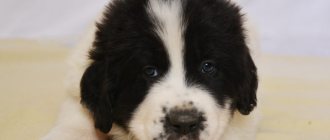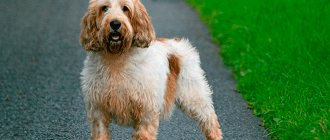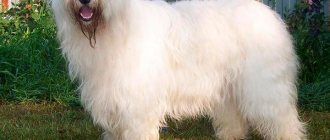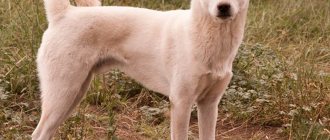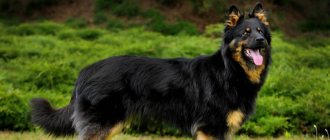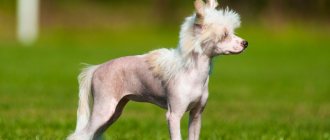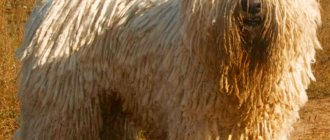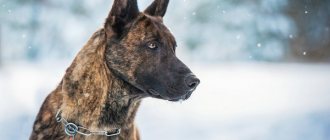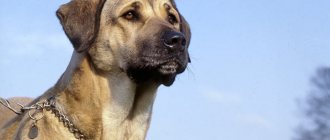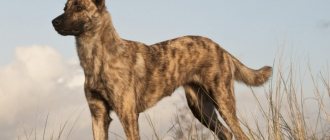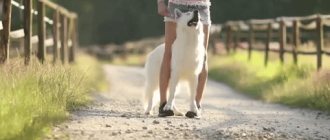The South Russian Shepherd is one of the few dog breeds bred on the territory of the former Soviet Union, and therefore is especially beloved among us. Gorgeous long white hair, the wayward character of the dogs, excellent guarding qualities - these are just a few of the facts that characterize this breed. This article will tell you why the South Russian Shepherd is interesting, how to properly care for its coat and what to pay attention to when raising a dog.
Origin of the breed
The Old Russian Shepherd has been known for several centuries. Its distant ancestor, the Asturian Shepherd Dog, was brought from Spain to the Crimea back in the 17th century, where it gradually mixed with local herding dogs. A lot of work on breeding the breed was done by sheep farmers, who bred dogs in the semblance of modern nurseries, selecting the largest and strongest ones to guard the sheep. This is how the breed of Russian shepherd dog emerged, which was noted at exhibitions at the beginning of the 20th century.
After the revolution and civil war, the breed was in danger of extinction. It was restored with great difficulty, thanks to the dogs preserved by shepherds in remote areas. In the 30s, the name of the South Russian Shepherd was officially approved, and the first breed standard was drawn up. During World War II, the Russian Shepherd almost disappeared again - at the end of the 40s, there were only a few dozen representatives of the breed in the entire country.
South Russian Shepherd Dogs were originally bred to guard herds of sheep.
It was very difficult to revive the South Russian Shepherd. Experts had to cross the surviving dogs with other breeds similar in appearance. But it has not yet been possible to restore the breed in full. In modern conditions, professionals and amateurs work together to breed and improve the South Russian Shepherd.
Breeding
In Germany there are two principles for breeding the breed: “high” (show) and “working” (sports).
There are several criteria by which individuals are allowed to breed. These include:
- Pedigree.
- Exterior of the dog.
- Psyche and performance.
- The quality of existing offspring.
More demands are placed on boys than on girls.
The duration of a female dog's heat is individual for each individual and depends on the characteristics of her body. On average, menstruation lasts 20-22 days. Girls can be knitted after reaching the age of 18 months.
Before mating, males and females must be introduced. You can do this, for example, while walking together.
Pregnancy and childbirth
Pregnancy lasts 61-65 days. In a month and a half, pregnant girls will have a rounded belly and enlarged nipples. But such signs also occur during false pregnancy. Invite a specialist to finally make sure of the interesting position of the bitch.
The birth process lasts on average from 6 to 18 hours. It depends on the experience of the female and the size of the litter. As a rule, 5-10 puppies are born at a time. If your girl is giving birth for the first time, invite an experienced breeder or veterinarian.
Puppies should be allowed to drink milk immediately after birth. The sucking effect stimulates the mother's contractions and provides colostrum for the babies. Remove those puppies that have already been born when new contractions begin. They can interfere with the birth of the next offspring. When he is born, return all the babies to their mother.
Some tips for caring for newborns:
- Prepare a secure box or crate. They should be large enough for mom and puppies to move around freely.
- Provide a heat source. Newborn dogs cannot maintain proper body temperature. Therefore, sometimes it is necessary to install a heating lamp at a safe distance.
- Monitor the growth and condition of each baby. Weigh each pet immediately after birth and record its weight. Healthy animals will weigh on average around 0.8-1.3 kg at birth and between 1.6 and 2.1 kg by the end of the first week.
- Healthy puppies are plump and strong. They eat about every two hours or until their belly is round. Well-fed puppies sleep peacefully. And pets who swallow air instead of milk will be restless and have trouble sleeping.
- Keep mom and baby's bed clean. Dogs can urinate right where they sleep. Therefore, change bedding daily to maintain a dry environment.
Description of the breed
The fluffy shepherd looks quite unusual and impressive. The combination of large size with a shock of wool makes a strong impression. The shepherd dog owes its appearance to its occupation from past centuries. The large shaggy dogs guarding the sheep looked very much like their charges, which misled predators. This allowed the shepherd to gain the advantage of surprise when charging at the enemy. The modern breed standard includes the following characteristics:
- strong bones, lean, muscular build;
- high height - 62-66 cm at the withers, average weight - from 35 kg;
- the chest is quite wide, deep, tucked in the stomach;
- the skull is elongated, wedge-shaped, with a smoothed transition from the forehead to the nose;
- triangular drooping ears, set high and medium in size;
- small, wide-set, oval-shaped eyes, brown in color, from dark to light;
- the nose is straight, tapering towards the end of the muzzle, black in color;
- powerful jaws with large white teeth, scissor bite;
- the neck is straight, strong, without dewlap, equal in length to the head;
- the coat is hard, thick, slightly wavy, of the same length throughout the body - from 10 cm;
- the undercoat is well developed, soft, light in color;
- coat color is white, light with a yellowish tint, gray with tan;
- the tail is lowered down and may be slightly curved at the end.
The shaggy appearance and color made the South Russian dogs invisible among the sheep, which had a surprise effect on predators.
The difference between the sexes is pronounced - males are larger and more massive, with a shorter body. Bitches are slightly lower at the withers, but have a more elongated body. The general impression of the dog is deceptive - it seems massive and clumsy due to its fur. But in reality it is a fast and agile animal with long strong legs.
Girl
You can tell a girl from a boy by height and weight. Knots are usually smaller. The standard weight of a female is 22-32 kg, height - 55-60 cm.
Some dog lovers claim that there are no differences in temperament and behavior between males and females. But there are still some nuances.
Women are more sensitive than men. Their smaller size, greater agility and temperament mean they are easier to train.
The female dog is sweeter and more tolerant of strangers and children.
A girl comes into heat twice a year if she is not spayed. It usually lasts two or three weeks. During this time, her secretions will attract male dogs from many kilometers away. This can make walking difficult.
Character
The South Russian Shepherd was bred as a service guard breed, capable of fighting and protecting the herd from predators. Therefore, the predominant valuable qualities in the selection were aggressiveness, fearlessness, and determination. These animals are distinguished by their intelligence, capable of assessing the situation and quickly making independent decisions.
Another striking feature of these dogs is their complete devotion to their owner. The South Russian Shepherd Dog obeys only one person, unquestioningly carrying out all his orders. She will protect the owner from any threat, will never show aggression towards him, and will also take under her protection those whom he points to. Therefore, keeping these animals in the family is quite safe, despite their natural aggressiveness.
The South Russian Shepherd chooses only one owner from the family; it regards the remaining members only as an object of protection
Such boundless devotion also has a drawback - the Russian Shepherd is rarely able to accept a change of owner. If the dog is handed over to a new owner, it will not trust his authority, and the strong melancholy from the loss of the old owner will affect the health of the animal. Also, the shepherd is unable to forget the person who caused harm to its owner - such a person will forever become an enemy for the animal.
Diseases and life expectancy
Despite their physical strength and endurance, South Russian Shepherd Dogs are susceptible to a number of diseases. These include both congenital and acquired pathologies:
- hip dysplasia;
- cataract;
- turning of the eyelids;
- gastric volvulus;
- allergy;
- osteoarthritis;
- lack of teeth;
- epilepsy.
Average life expectancy is 12-15 years. Early death can occur from improper care, injury and lack of physical activity.
Training
When guarding a herd, Russian Shepherds remain alone for a long time, so they are able to make decisions without human intervention. This makes their character independent, and training is quite difficult, especially for an inexperienced person. The dog regularly tests even its owner for strength, and therefore requires a strict attitude towards itself.
Visually, thick and long hair makes South Russian Shepherds clumsy, although they are very dexterous dogs
Raising such a pet requires a lot of patience and strong will, and the consequences of poor training can make the dog dangerous to others. Therefore, before getting a South Russian Shepherd, you need to objectively assess your strengths; understand whether you can train the animal correctly and pay enough attention to it.
How to train
The characteristics of the breed affect not only the physical development and maintenance, but also the upbringing of the animal. Successful training begins with early socialization of the puppy. The owner must teach the Yuzhak to obey orders, otherwise the innate aggression will get out of control. It happens that shepherd dogs suppress the personality of the owner, ignore commands and dominate. This leads to dire consequences.
The training of the South Russian Shepherd should be carried out by a professional dog handler. If an unprepared person gets down to business, he can make a number of fundamental mistakes that will lead to the formation of a pattern of aggressive behavior.
Don't try to train your dog yourself! If unsuccessful, the dog cannot be transferred to another owner or sent to a shelter.
Security qualities
The South Russian Shepherd Dog considers its main duty to protect the territory that its owner has entrusted to it. Modern representatives of the breed are excellent guards. These dogs have acute hearing, a sensitive sense of smell, and feel confident even in a large security area. Russian Shepherds are often bred as guard dogs for permanent keeping in suburban areas.
The South Russian Shepherd is great for guarding a country house
The only drawback of the animal can be considered increased aggression, which at times turns into bitterness. This dog will perfectly protect the yard from burglars, but it can also cause harm to neighbors or children who carelessly enter the territory.
Nicknames
For boy
Modern names for boys:
- Alex.
- Apollo.
- Atlas.
- Boris.
- Brunson.
- Bruno.
- Captain.
- Cain.
- Duke.
- Dino.
- Ernie.
- Fletch.
- Fido.
- Freddie.
- Goliath.
- Hercules.
- Harley.
- Larry.
- Maximus.
- Rex.
- Newton.
- Lobster.
- Owen.
- Omega.
- Polo.
- Rudy.
For girl
Popular nicknames for girls:
- Angel.
- Alian.
- Aba.
- Abigail.
- Annabelle.
- Athena.
- Alexandra.
- Anna.
- Ava.
- Blair.
- Boni.
- Chloe.
- Cassie.
- Cleopatra.
- Erika.
- Elsa.
- Venus.
- Gloria.
- Hayley
- Isabel.
- Lucy.
- Milli.
- Mia.
- Maxi.
- Rose.
- Rachel.
Family care
Despite its cautious and independent character, the Russian Shepherd is quite sociable and enjoys communicating with its family.
Submitting to the will of the owner, the dog will never harm a family member, but his attitude towards other people is condescending, without respect. The dog treats other pets in the same way, considering himself the leader of the pack. If her right to the hierarchy is challenged, other animals could be seriously harmed.
IMPORTANT: If there are small children in the family, the dog will not touch them, but will not be patient with their games. The dog may carelessly push the baby or snap at his obsessive attempts to pet him. It is also dangerous to give a shepherd puppy to a small child or teenager - he will not be able to properly raise and control the dog, so it will quickly become uncontrollable.
The South Russian Shepherd must be brought up strictly, otherwise you may end up with a dangerous and uncontrollable shepherd.
Additional Information
Yuro should not be left alone with the child, especially when the upbringing process has not been completed. At the same time, the dog associates its owner with the leader of the pack. Accordingly, a family is its members and they need to be protected. On the one hand, the dog is not distinguished by its good disposition, but on the other hand, it is very devoted, faithful and capable of self-sacrifice (subject to proper socialization).
It is noteworthy that the YuRO chooses its owner for itself. When walking with her, you must not enter into conflicts with others, otherwise the dog will see the person as an enemy and may even cause harm. Also, such a pet is not the best gift for a child, because at the slightest disagreement with his parents, the dog will protect his little friend.
Health
The breed was bred to live outdoors at any time of the year. For this purpose, the strongest and hardiest individuals, reliably protected by warm wool, were selected for breeding over the years. For this reason, the modern South Russian Shepherd is distinguished by good genetics and excellent health.
Representatives of the breed live up to 15-17 years - a long time for a large breed of dog. Thanks to their strong immunity, animals almost never get sick, and their thick coat protects them from hypothermia in the winter months. An abundant undercoat also helps to avoid infection by fleas and lice-eaters - insects simply cannot reach the skin.
IMPORTANT: Health problems can begin from lack of movement. A herding dog needs serious exercise, long walks, and exercise. Otherwise, there is a danger of developing diseases of the cardiovascular system and skeleton.
Mating
Mating must meet the requirements for the mating process of large breeds:
- The first mating takes place at 24 months ;
- The mating period is between the 11th and 14th day after estrus (usually the third);
- Introducing dogs - in the territory of the dog;
- Time – preferably in the morning, after a long walk; It is not recommended to feed animals;
- Repeated mating - every other day.
Puppies
Small South Russian Shepherd Dogs are fluffy and clumsy, with sparkling eyes. Due to the special attitude towards the owner, puppies are handed over to new owners quite early. It is better not to take a puppy who is already four months old - his independent character has already begun to manifest itself, so it will be more difficult to establish the correct hierarchy.
After 4 months, a South Russian Shepherd puppy develops an independent character, which significantly complicates its upbringing
When choosing a puppy, you need to pay attention to its behavior. He must be active, inquisitive, and you can often see attempts to fight and dominate his brothers. You should not adopt a puppy of this breed if he demonstrates lethargic, phlegmatic behavior. Be sure to find out about the cub's temperamental characteristics from the breeder - this will help during training.
Learning ability
Shepherd dogs in general - South Russians are no exception - are excellent trainees. Their training is not difficult with the right approach. It is only necessary to exclude harsh methods and punishments.
You can teach a Yuzhak almost any command. You just need to take into account the size, age and temperament of the dog.
It may take literally a few repetitions to learn a new signal. It will take a little more time to consolidate the skill. There are no special secrets here - you need to periodically repeat and remind your pet what and how to do.
Care
When keeping a South Russian Shepherd, you will have to pay great attention to caring for its long hair. The dog must be brushed daily, first with a coarse brush, then with a comb with metal teeth, otherwise the soft undercoat will become tangled. Particularly careful care will be required during shedding, when the fur comes off in large clumps. It is very difficult to wash a dog entirely; it is not recommended to do this more than several times a year.
Both ready-made dry and wet food and natural food are suitable for feeding the dog. Despite its large size, the South Russian Shepherd requires relatively little food; overfeeding can lead to diseases. In order for natural nutrition to be correct, it is recommended that a diet be drawn up by a veterinarian.
IMPORTANT: It is better to choose ready-made food from premium brands, then you can be sure of the health of your pet. Complete feeds are verified in composition and calories, balanced in the content of vitamins and minerals, so natural food cannot be given in addition to them.
Nutrition
It is strictly forbidden to overfeed your dog. They eat small portions twice a day. The portion should be calculated according to the following formula: per 1 kilogram of animal weight there should be 50 grams of food and a lot of clean water.
The dog needs a balanced diet with sufficient amounts of proteins, fats, carbohydrates and fiber. Be sure to include in the diet:
- lean meats (turkey, chicken, beef and veal);
- cottage cheese and other fermented milk products;
- fresh vegetables and fruits;
- boneless fish;
- chicken eggs;
- porridge cooked in broth.
You should not give foods that cause bloating: corn, peas, cabbage and potatoes. It is also not recommended to feed fatty foods and tube bones. Dry food of the highest quality is allowed in small quantities.
Price
Depending on the pedigree, the price for a South Russian Shepherd puppy ranges from 250 to 1000 dollars. If you buy not through a kennel, but directly from a breeder, you can buy a dog that is relatively inexpensive. But in this case, you need to carefully study the reputation of the seller to avoid the risk of getting a puppy with defects or diseases. Animals for exhibitions are purchased only through large nurseries, where all documents are provided.
The breed standard allows for a white coat with a yellowish tint
Attitude towards children
Dogs of this breed are suitable for families with small children. The specificity is to initially explain to the dog what place she and the child occupy in the family. The South Russian Shepherd is a strong and independent dog. She just needs a strong and confident owner. With such a tandem there is no danger for children.
It is important to remember that it is not recommended to leave a large dog alone with small children for a long time. In the absence of control, the behavior of both is very unpredictable. It is difficult to predict the reaction of a four-legged pet to new and unusual actions of a small person. This, by the way, applies to absolutely all dogs.
Reviews
Konstantin:
We have had a lot of dogs on the site, the Yuzhak is the best guard. Very loyal, but really aggressive towards strangers. There have been several cases of people ignoring dog warnings and getting bitten. Although for the most part our dog only growled at the person who came into the yard. Choose a southerner only if you are sure that you can raise him correctly.
Yuri:
An unusual, beautiful dog, it protects its territory with great zeal, is obedient and patient with its family. It is not difficult to care for, apart from combing the fur, it does not eat much. But she definitely needs to be kept strict, she has a stubborn character.
Valentina: The dog lived at our house for 14 years, then we moved him to the dacha. He loved and protected everyone in the family, did not trust strangers, and obeyed only his father. A very beautiful breed with long hair that flutters while running, the bangs covering the eyes. The character is complex, but if raised correctly from childhood, the dog will be obedient.
Kinds
There are a sufficient number of varieties of shepherd dogs relative to breeding lines:
- German: working lines.
- German: exhibition lines.
- German: East German line.
- Czech/Slovak.
- American.
- Old American.
- Old type.
- English.
- Swiss (mountain).
- Belarusian.
- Caucasian.
- Russian.
- Chinese.
- Central Asian.
And:
- Panda.
- Shepherd dogs without a mask.
- Shiloh Sheepdogs.
- Royal Shepherd.
- Old style German Shepherd.
- Kunming Shepherd.
- Sarlouz Wulfhound.
- Utonogan.
- American tundra.
- Dwarf.
- Gypsy.
- Black German Shepherd.
Photos of different types are presented below.
Longhair
The long-haired type (long-haired) is not considered a separate breed. The recessive gene for long hair is present in all lines and subspecies of individuals. It may appear unexpectedly. Sometimes a slight lengthening of the hairs is possible, and the appearance of very long hair is possible. In such cases, caring for your pet will be more difficult.
The photo is presented below.
Intelligence
The German Shepherd is considered to be one of the smartest dogs known to man. Poodles and border collies also share this title with the “German” - these dogs are among the three smartest.
Training for a shepherd is always a joy. She willingly learns new commands and performs tricks. This breed can memorize up to 20-30 different commands, and some “tailed geniuses” master over 50 commands. It’s not for nothing that “Germans” are often used to film films and TV series - they can fulfill any whim of the director.
General characteristics of German Shepherds
German Shepherds are unique dogs. Their main characteristics are amazing performance, versatility and adaptation to humans. But for this dog to truly become a friend and protector, you need proper training, sufficient care, and most importantly, give him a lot of attention and love.
German Shepherd
The purebred German Shepherd is not very large, but hardy and agile. In terms of height and weight, it belongs to large breeds, although some females weigh a little more than 20 kg. Life expectancy is 10-13 years. These are flexible, loyal pets. They are smart and recognize the authority of their owner.
pros
German Shepherds have long occupied first place in ratings of the most intelligent, efficient and loyal dogs. Judging by reviews from breeders, they are also popular because of their appearance. This breed has many positive qualities and advantages over others.
- Stable psyche, lack of aggressiveness, great sensitivity. They understand the owner’s mood and can predict his desires. This makes the Germans the best guides and bodyguards.
- High intelligence and learning ability allow them to be used for any job. These shepherd dogs can guard a room, protect, search for drugs or explosives, and save people. This is a versatile service dog.
- These are calm, playful, affectionate pets. They are not conflicting, not aggressive. They are kind to children, protect them, and get along well with other pets.
- They are unpretentious and picky, quickly adapting to home conditions. They can live outside even in winter and get used to being kept in an apartment. They don’t create any problems with nutrition either—they eat everything they’re given.
- They are sociable, loyal, and unforgiving. They get used to one owner and have a hard time parting with him.
- Unlike many other breeds, the German is beautiful, elegant, agile and hardy.
Minuses
But German Shepherds, like any other breed, have disadvantages. Much depends on the owner, so this dog is not suitable for everyone. The disadvantages of the breed include:
- due to its size, a lot of space is required; a German will feel uncomfortable in a small apartment in the city;
- strict education is necessary, it is important to show patience and perseverance;
- a general training course is required, preferably under the guidance of an experienced dog handler;
- they can be stubborn;
- long walks are important; in the absence of sufficient physical activity, they grow uncontrollable;
- they are loyal to one owner, they can show aggression towards people around them and even bite;
- This pet will produce a lot of hair, especially during shedding, and you can also smell the dog.
You can watch a video about the pros and cons of the breed.
Video: German Shepherd. Pros and cons of the breed
Varieties
Now there are several types of German Shepherds. The wide popularity of the breed has led to breeders in different countries developing new varieties. Several lines have become widespread, with slight differences between them:
- the purebred german or classic line of the breed is distinguished by loyalty and goodwill towards people;
- German Shepherd working dog is used for police work;
- Eastern - these are calm dogs with a strong build;
- the English one was bred for military purposes;
- American are shepherd dogs with a soft, kind character and an angular build;
- The difference between the Czech line is that they are very hardy.
Mixed breeds or crosses of German Shepherds with other breeds are usually friendly and intelligent, but lose their service qualities. They are crossed with other shepherd dogs, Alabai, Rottweilers and even with a wolf. It is difficult to say which type of German Shepherd is better. It depends on the purpose for which you are getting a pet. And to understand what the difference is, you need to look at photographs of different types.
Black German Shepherd
German Shepherd
Interesting Facts
German Shepherds are unique working dogs. There are many interesting facts associated with them.
- These dogs saved many people and helped during the war. They carried cartridges, carried the wounded from the battlefield, and worked as sappers. Often they died and even sacrificed themselves. There is evidence that more than 60 thousand German shepherds served at the front during World War II.
- They can reach enormous speeds - up to 50 km/h, and are very maneuverable in their movements. They do not stumble and can turn and brake sharply.
- They have powerful jaws. The clamping force is up to 100 kg/cm2.
- Thanks to their attractive appearance, they often appear in films, participate in TV shows, and various competitions.
- German Shepherds are the first breed to be used as guide dogs. They are not only obedient and calm, but they are well oriented even in unfamiliar areas.
- There are three monuments in the world dedicated to this breed.
- The price of a purebred German Shepherd can reach $900.
The main characteristics of this dog can be found in the table:
| Options | Characteristic |
| Temperament | Kind, loyal, calm, moderate aggressiveness |
| Activity | Very agile, resilient, fast, needs a lot of physical activity |
| Training | Very easy, can be taught any commands, suitable as a guide dog |
| Intelligence | Tall, have intuition |
| Wool | Sheds heavily twice a year and has a dog smell |
| Care | Unpretentious, does not require special conditions of detention |
| Health | Average life expectancy – 9-14 years |
Interesting Facts
Owners of shepherd dogs notice many interesting behavioral features in them, and experienced hereditary breeders can share unusual facts from the history of the breed.
- Despite the fact that the ancestors of the German Shepherd are more than 3 thousand years old, this is one of the youngest breeds - it is just over 100 years old.
- Despite their age, Germans are one of the most popular dogs on the planet. Their appearance is familiar to everyone, and, according to observations, when most people hear the word “dog,” they think of a German shepherd.
- Shepherds are excellent actors. Thanks to their high intelligence, they are often featured in films - they cope well with roles, listen to commands flawlessly, repeat the same type of actions many times and are able to work for many hours in a row.
- German Shepherds are not only police officers, but also soldiers. They participated in wars and were in many hot spots, where they provided assistance to the wounded, carried food, water and medicine.
- After the Great Patriotic War, they wanted to rename German shepherds, but none of the new names took root for a long time. Moreover, even the association with recent enemies did not spoil the attitude towards these intelligent and noble dogs.
- Shepherds can become foster parents. They “adopt” not only other people’s puppies, but also kittens, wolf cubs, fox cubs and even tiger cubs.
- The bite force of a shepherd is 80-100 kilograms, which can easily break human bones and even kill. True, they attack only when threatened.
- Almost every country in the world has a story about the famous shepherd hero, which is why monuments to them have been erected in many cities.
